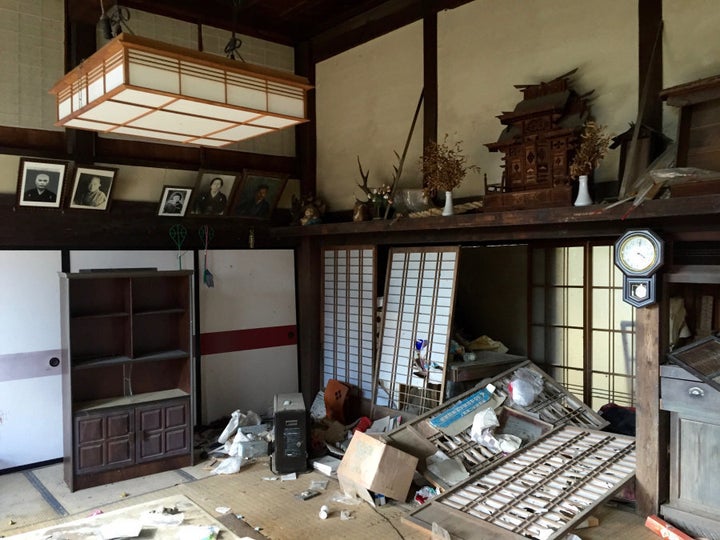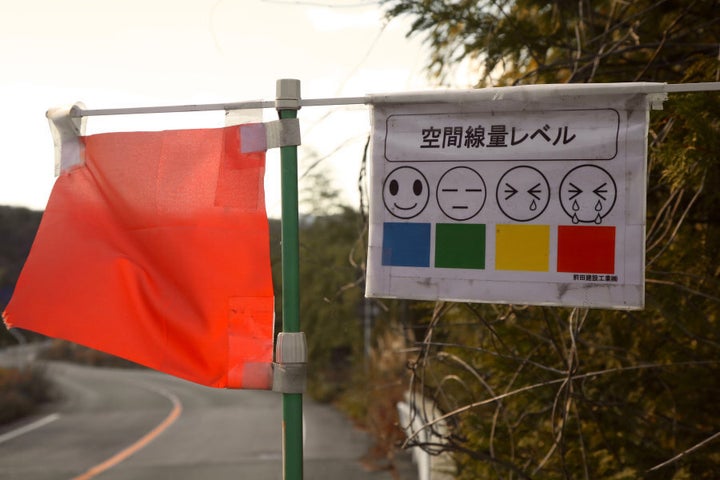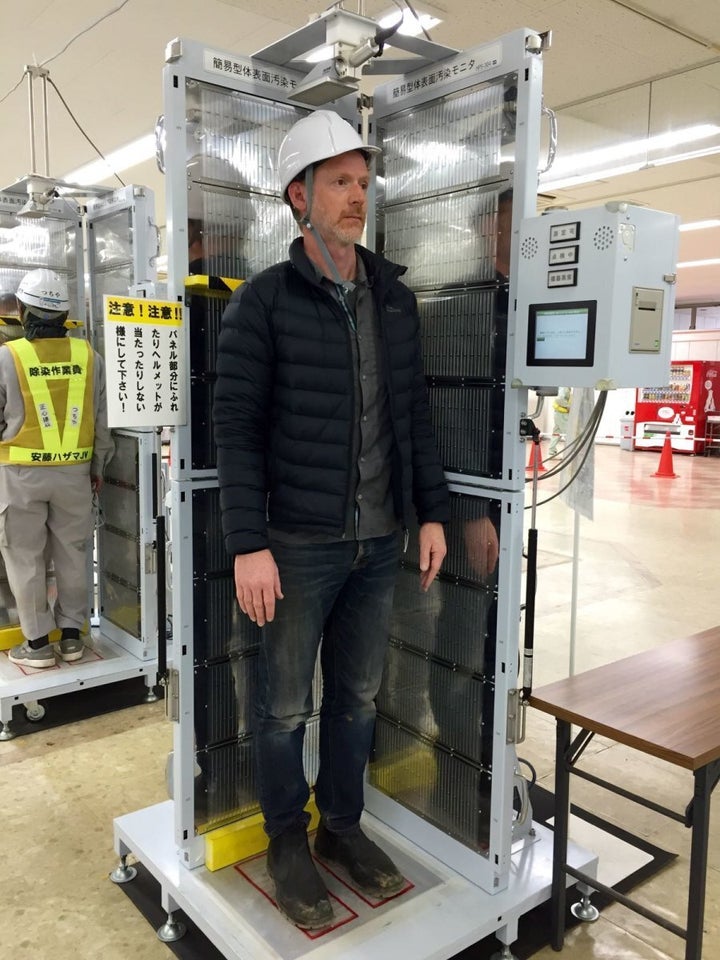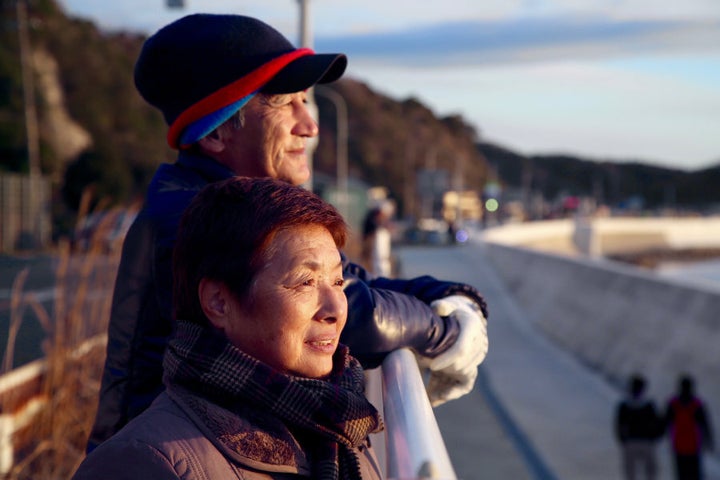
In a country that prizes order and tidiness, the derelict ghost towns of Fukushima come as a shock. They're littered with collapsed buildings and rusting, abandoned cars; cracked sidewalks are overgrown with weeds.
There can be a melancholy beauty to places abandoned by humans and overrun by nature -- a few days ago I was filming the ruins of old steel factories and coalmines in northern France -- but in Fukushima the desolation just felt sad, and a little threatening.

Sad, because there were reminders everywhere of lives that had been suddenly and irrevocably interrupted. Calendars still displayed March, 2011, marked with appointments that were never met. Household bills lay on the floor, trampled by the wild boars that now roam here. Household shrines have become homes to mice.
And threatening, because of the invisible danger of radiation. Colour-coded roadside flags use emojis as warnings -- a red flag displays a face with eyes scrunched shut and falling tears. The red zone is close to the Fukushima Daiichi nuclear power plant, where hundreds of tonnes of toxic fuel leaked out of the reactors six years ago. No one has yet worked out how to safely remove the debris so the plant can be decommissioned -- in fact, they don't even know precisely where it is. The levels of radiation are so mind boggling that it kills off the robots sent to measure it.

Equipped with a Geiger counter, I was warned to spend no longer than an hour filming in a nearby town -- after which a team of masked workers in immaculate protective suits scanned us for radiation before giving us the all clear and bowing deeply as we drove away.

Many of the workers at the power plant lived in the town of Namie, just 11km away, and the government is now assuring former residents that it's safe to come home. Namie was home to almost 20,000 people, but its bustling port was wiped out by the tsunami; the rest of the town bears scars from the earthquake, and years of municipal neglect. But it doesn't feel as desolate as towns in the red zone. Every day, hundreds of decontamination workers fan out from here to the surrounding countryside where they scoop up radioactive topsoil and seal it in large plastic bags. (Finding people willing to do such a dangerous job isn't easy -- there are reports that homeless men and even asylum seekers have been put to work.)
When I asked people why they were unwilling to go back, they rarely mentioned a fear of radiation.
According to Greenpeace, over 9 million cubic metres of nuclear waste is scattered across more than a hundred thousand locations across Fukushima prefecture. And while the government has been vigilant about monitoring radiation levels in towns that have been decontaminated, there are grave fears of radiation spreading from surrounding areas that are still contaminated. What happens when a storm strikes and wind and rain carry radioactive soil and leaves from the mountains that border Namie?
So I wasn't surprised to learn that less than 20 percent of Namie's former residents want to return. But although many of the people I spoke to were indeed daunted by the prospect, it wasn't for the reasons I imagined.
When I asked people why they were unwilling to go back, they rarely mentioned a fear of radiation or questioned the government's reassurances. Instead they mentioned things such as jobs, children and hospitals. Every family seemed scarred by the trauma of forced dislocation in its own unique way, and their reluctance to return often stems from this.
For some it was the loss of meaningful employment in a business that has been passed down from generation to generation -- what point is there in reopening a toy shop in a town without children?
For others it was worrying that close family ties would fray if they moved further away from their grandchildren, or a serious heart condition that requires regular blood tests -- Namie won't have a hospital when it reopens.
Such domestic dilemmas might not seem as sensational as headlines such as 'Radioactive Boars in Fukushima Thwart Residents' Plans to Return Home', but they're a good deal more true to life.
When I asked Shigeko Watanabe, who owned a printing business in Namie, why no one I'd met questioned whether or not it was safe to go back, she told me that while there were some people smart enough to research these things on their own, "people like me just have to believe. Maybe it's because if we talk about it too much we'd be frightened to even consider rebuilding."
She'd come back to show me her old home, and said: "If I was afraid of radiation I'd wear a mask, but look at me, I don't wear anything, I'm not scared."

The elderly can afford to be more cavalier about the risks -- low levels of radiation need to be absorbed by the body over many years before they become dangerous, and years are in short supply when you're over 70. A friend of Shigeko served her some persimmons collected from his garden in Namie -- he'd had them tested for radiation and declared safe by the local hospital, but admitted that he'd never feed them to his grandchildren.
I did meet a woman with three children who was worried about the radiation in her hometown -- but in Hisae Kamata's case, life as an evacuee had become so unbearable that it actually drove her back despite her fears.
"Before the earthquake, actually I was proud of the nuclear plant. My father was working at the Daiichi plant. He often told me that electricity that he makes goes to Tokyo for everyone there to use. I was very proud of it. That pride was taken away from me and I become depressed."
Hisae's depression worsened when her landlord started bullying her. This is surprisingly common. Nuclear evacuees receive compensation through a fund set up by the government, and this sometimes makes their neighbours, who were often victims of the tsunami themselves, jealous and resentful -- especially when the media reports on isolated cases of people splurging on fancy cars and holidays.
"People who watched TV would say to us, 'Good on you, you get money without working,'" Hisae told me. "In my head, all I could think about was dying. I was thinking that all the time."
When her hometown of Naraha, not far from Namie, was reopened at the end of 2015, Hisae felt like she'd been thrown a lifeline.
"Around the time, I couldn't move around due to the depression. It was severe and I couldn't get up. But I was able to get up if it was to go to Naraha. I even refused to wear protective suits, I just went in. I went into my house and my room, and I cried my guts out. "
They weren't complacent about the risks. Hisae's husband would frequently monitor radiation levels around their house and call in the council for further decontamination if he detected a hot spot. They built a wooden deck so their children could play outside, but above the ground.

Naraha was the first of the evacuated towns to be reopened, so Hisae's family became nuclear pioneers, boldly going where so many hesitated to go. Just over 10 percent of the 7,400 residents have returned, and two thirds of these people are aged over 60. Hisae's youngest child is a novelty, doted on by everyone, and Hisae's depression has faded away.
"Although there is not many people around me, everyone is a friend."
_________
See more of this story 'Coming Home to a Nuclear Wasteland' on Dateline tonight, Tuesday 14 March at 9.30pm on SBS. The episode will be available after broadcast via SBS On Demand.
People